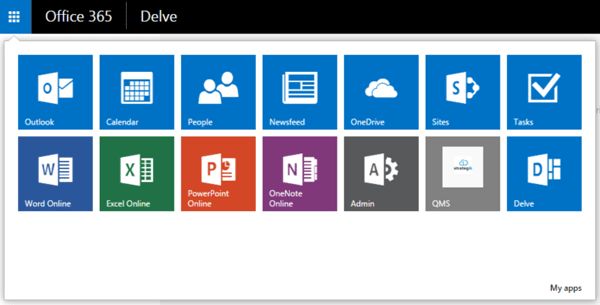Sharepoint or the cloud?

It seems that barely a day goes by when we don’t see another announcement about Office 365. New (Australian data centre hosted) offerings to be available by the end of March 2015, the ongoing integration of Yammer, the launch of Delve and the Office graph, Smart Portals, Office extended to all devices and platforms, continual changes to the app development story, single sign on in the cloud using Azure Active Directory, OneDrive for business offering unlimited storage. The list goes on and on.
Yet at the same time Julia White (General Manager of the Office Product Management team) recently announced the impending release of the next version of SharePoint (SharePoint 2016) to be available both on premise and online. That’s left many wondering where next, should we continue with our investment in SharePoint on premise or is it time to move to the cloud?
It’s a conversation I’ve frequently had with my enterprise clients. The right answer really depends on your own particular circumstances, history and what you are trying to achieve. It’s a rapidly changing story. Through this article I share some insights into where we are today, ideas to help you make informed choices and my thoughts on where I believe we are heading next.
First - Ask the right Question
One of my Office 365 clients called me recently in a bit of a panic. “I can’t find SharePoint," he said.” He was looking at the new Office 365 app launcher functionality. The words SharePoint are nowhere to be seen.
That’s no accident. SharePoint is yesterday’s product, it is not Microsoft’s strategic bet for the future - Office 365 is. The conversation is no longer about individual products but rather the Office platform as a whole. SharePoint on premise and Office 365 are fundamentally different things. Office 365 requires a shift in our mindset and approach.

This is about Office (and the extensibility of office) on every platform and device. What’s left of SharePoint in the online world is quickly being de-emphasized, unbundled and subsumed into this altogether larger and more exciting beast.
So the question that we must really ask is: “Do we need SharePoint or Office 365?” To start to answer this we must step back further and consider (from a business perspective) why we need anything at all. SharePoint became popular because it appeared to offer the nirvana of ubiquitous collaboration, workflow and custom enterprise solutions.
For many that is a dream yet to be realised. I visit far too many clients who have made virtually nothing of the SharePoint’s capabilities. They are on their third “intranet re-launch” and their number one business requirement is “put the weather on the homepage”. Yet another intranet is just tired, 1980’s style thinking perpetuated by consultants who neither understand the technology or the businesses they are trying to serve. Meanwhile, organizations continue to suffer information management chaos, unable to distinguish the important from the irrelevant, with communication and collaboration dumbed down to the ubiquitous “email broadcast”.
SharePoint projects are too expensive and have an unacceptably high failure rate. The reasons are obvious: expensive infrastructure; complexity and cost just to install the product; confusion over its capabilities and the best way to implement them; failure to grasp the governance and cultural changes that underpin any successful SharePoint installation; ambiguous business requirements and intended value of the implementation; unnecessary customizations; the need to recruit and retain expensive and specialized administration and development staff; Insufficient resources applied to get the project completed correctly. I could go on and on. Any or all of these can derail even the most well intentioned SharePoint implementation project. For an enterprise deployment, you need to start with a budget of around $1million once you add in all your wage costs with absolutely no guarantee of success.
Too often SharePoint is the solution looking for a business problem to solve. We must ask ourselves: What are the Information management challenges we really need to solve?
For many businesses, up to date technology stack, strong email, task management and instant messaging, good document sharing and social features, secure and accessible at any time on any device addresses most of their basic collaboration, communication and information management needs.
The Benefits of Adopting Office 365
There has to be a better way - enter Office 365.
With Office 365 you get infrastructure that you no longer need to maintain at a price you no longer need to worry about. Turned on with the “flick of a switch” it is ridiculously cheap when compared to the on premise alternative. Adopting Office 365 provides instant access to Microsoft’s latest technology and their continual innovation ensures that you are always up to date.
Office 365 is not just SharePoint. It provides a complete Information Worker toolkit, delivering powerful and seamless collaboration both within and across organisations. It is the Office we know and love, to be accessed anywhere and from any device. Out of the box, Office 365 gives a solid collaboration backbone of email, instant messaging and social features through Exchange Online, Lync and Yammer. It provides powerful communication capabilities through its “Next Gen Portals”, powered by the new Office Graph to ensure that relevant information “comes to you”. Collaboration is delivered through OneDrive for enterprise file sharing and (of course) the site based collaboration, business intelligence, electronic forms and workflow capabilities (formally known as) SharePoint.
Then add into the mix subscription based licensing, paying only for what you use. Office 365 completely levels the information worker playing field. Now a one man company can access the same technology as the largest enterprise.
For larger customers, Microsoft has created a fast track implementation methodology designed to get a pilot implementation up and running in hours. If you’re struggling with out of date technology, failing SharePoint projects and obstructive technical staff then moving to Office 365 is a no brainer.
Beware the Downsides
When people talk about the cloud I always wonder “is it going to rain”? There are no silver bullets in enterprise technology. That’s as true today as when Fred Brooks first coined the phrase nearly 30 years ago. There are certainly downsides to Office 365 today. It would be remiss of me not to point them out. Most importantly, Office 365 is an unfinished masterpiece. While the overall strategy and intent appear clear, Microsoft are very definitely still working out the details. Witness their recent acquisitions of Acompli and Sunrise, the unfinished integration of Yammer and the confused message on the future of InfoPath forms. In essence, that’s what you sign up for when you opt for the cloud, the shifting sands of ever changing innovation and a corresponding loss of control. However, later in this article I outline a timetable where I expect all will be revealed. My strong advice is to not make any big decisions until then.
When it comes to some of the functionality delivered by Office 365, Microsoft is again guilty of delivering something that looks like (but performs far worse) than a competing product. Don’t get me wrong, Exchange and Office are beyond compare. But OneDrive? – I am afraid that is a different story. Unlimited storage, yes, better than Drop Box – no way. If you don’t believe me try them both for yourself and see how you get on. That’s not to say that OneDrive won’t get there, and Microsoft recently announced a one year roadmap to unify its consumer and business products with exactly that intent. But that’s an implicit admission that it’s not there yet. Right now OneDrive for Business is the ugly duckling, let’s hope they can turn it into a swan.
Finally, there is no simple way to deliver complex technology projects across the enterprise. Office 365, like SharePoint before it, means process realignment, retrenchment and cultural change. This requires smart thinking, bright people and good project management to get it right. The technology works, but that’s only half the battle. When it comes to Office 365 there is a serious problem when trying to hire the right help. For traditional infrastructure consultancies, Microsoft has shot their golden goose. No longer able to charge large sums for simply installing the product they are struggling to develop new consultancy models for the cloud based approach. Likewise beware the information management consultancies who “don’t do” (that’s code for don’t understand) technology. If you are serious about moving to Office 365 make sure you consult with people who really know the product.
It’s all about “Apps”?
Never was there a term so over used and confused. In the SharePoint world, apps (as a complicated, discrete and confusing extension technology) were unleashed on a disapproving and hostile SharePoint community back in late 2012. Since then it’s reasonable to say that they have received virtually no traction in on premise deployments. However it’s a different story in the cloud. Microsoft have recruited well know SharePoint MVP Jeremy Thake and have assembled a formidable internal team solely focused on evangelizing the new app models for Office 365. They have continued to evolve the development story, created loads of free training and built pathways to transition traditional on premise solutions. There are new cloud only APIs, integration and tooling.
As it stands today, the extensibility options for Office 365 are far beyond what can be achieved on premise. That’s something I expect we will hear a lot more about in coming months. It is not SharePoint apps that are important, its Office apps, designed for the enterprise and running anywhere Office runs, developed with modern web technologies, using cloud based identity management and utilizing the Office graph and other Office 365 APIs.
Understand the Timeline
Microsoft under Satya Nadella have ushered in a new spirit of openness and a new direction for the company. There is a clearly laid out timetable for announcements over the next few months. Pay particular attention to the Office 365 summit in Sydney on the 30th/31st March. This is a free Microsoft hosted event with top class speakers. Following that, Build 2015 (29th April – 1st May, San Francisco) will reveal what’s new from the developer perspective across the Azure, Office 365 and Windows 10. That conference is back to back with the main event, the new Ignite conference (4th – 8th May, Chicago) – where Satya and other key Microsoft execs will share more of their cloud first, mobile first vision.
Who knows we might even see an early preview or a beta of SharePoint 2016 too. My clear advice is wait (if you can) until after the Ignite conference in May before making any big SharePoint v Office 365 decisions. However, if you really must do something today, this flowchart provides some deployment choices.

In my experience, regulatory objections are almost always imaginary rather than real, unless you are working in obviously sensitive areas such as defence. Office 365 is available in secure Australian data centres from the end of March 2015. From that point, many previously articulated objections on data sovereignty and latency are simply no longer valid. Cloud technologies are threatening to technology professionals and traditional IT departments alike. Many arguments advanced against their adoption are simple smokescreens designed to preserve employment and maintain the status quo.
There is a well-known saying, “all roads lead to Rome”. When it comes to SharePoint “all roads lead to the Office 365 cloud”. Time may prove me wrong but I don’t expect SharePoint 2016 to be anything more than a hybrid deployment designed to provide an easy bridgehead through which enterprise workloads will be moved to Office 365. Nor do I believe that there will be an appetite or desire for another version of SharePoint on premise 2019 or beyond. Ultimately the choice will become get on board Office 365 or adopt something else. Over the next 5 months much will be revealed. Don’t be under any illusions, Windows 10 and Office 365 are front and centre of Microsoft cloud first, mobile first strategy. Perhaps they should be yours too? There is no plan B - these are exciting times.
 Dr Adrian Colquhoun is an independent consultant, author and entrepreneur. He is the founder and managing director of Strategik a Brisbane based consultancy. Contact him at adrian@strategik.com.au
Dr Adrian Colquhoun is an independent consultant, author and entrepreneur. He is the founder and managing director of Strategik a Brisbane based consultancy. Contact him at adrian@strategik.com.au
